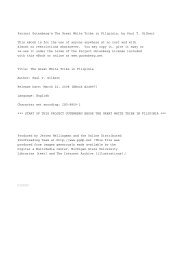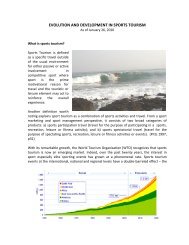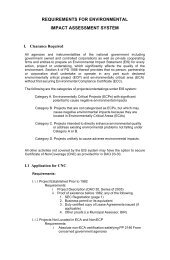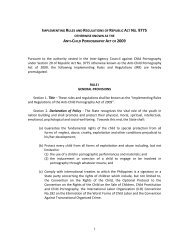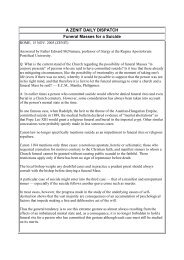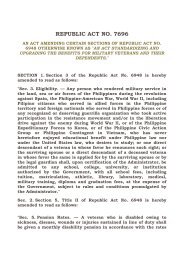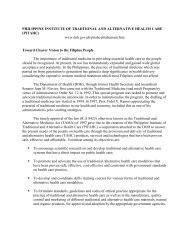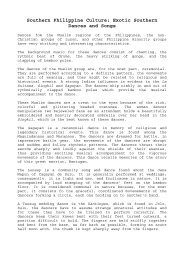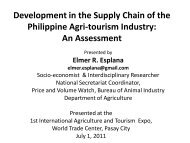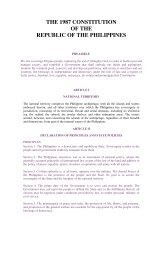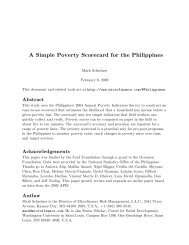Bangus or Milkfish Cultivation Systems in the Philippines
Bangus or Milkfish Cultivation Systems in the Philippines
Bangus or Milkfish Cultivation Systems in the Philippines
You also want an ePaper? Increase the reach of your titles
YUMPU automatically turns print PDFs into web optimized ePapers that Google loves.
onion, tomatoes, rice wash<strong>in</strong>g and bagoong), rellenong bangus (f<strong>or</strong>merly a party dish; now available<br />
even <strong>in</strong> school cafeterias), and bangus lumpia.<br />
Also known as milkfish, bangus (scientific name: Chanos chanos) is most closely related to carps and<br />
catfishes. It occurs <strong>in</strong> <strong>the</strong> Indian Ocean and across <strong>the</strong> Pacific Ocean, tend<strong>in</strong>g to school around coasts<br />
and islands with reefs. A warm water species, it prefers water temperatures between 20-33 degrees<br />
Centigrade.<br />
In <strong>the</strong> Philipp<strong>in</strong>es, bangus can be raised anywhere. However, <strong>the</strong> top bangus produc<strong>in</strong>g prov<strong>in</strong>ces are<br />
Bulacan, Pangas<strong>in</strong>an, Capiz, Iloilo, and Negros Occidental. The most recent rep<strong>or</strong>t released by <strong>the</strong><br />
Bureau of Agricultural Statistics (BAS) show that <strong>the</strong> comb<strong>in</strong>ed production of <strong>the</strong>se five prov<strong>in</strong>ces alone<br />
accounts f<strong>or</strong> m<strong>or</strong>e than 50 percent of <strong>the</strong> country’s total production.<br />
Rais<strong>in</strong>g bangus can be done employ<strong>in</strong>g different production systems <strong>in</strong> freshwater and <strong>in</strong><br />
brackishwater. “Depend<strong>in</strong>g on <strong>the</strong> available resources and level of management, <strong>the</strong> culture methods<br />
can vary from <strong>the</strong> traditional <strong>or</strong> extensive system, <strong>the</strong> modular <strong>or</strong> semi-<strong>in</strong>tensive to <strong>the</strong> <strong>in</strong>tensive<br />
system,” acc<strong>or</strong>d<strong>in</strong>g to <strong>Milkfish</strong>: A Basic Domestic Need Commodity, a primer published by PCAMRD.<br />
The semi-<strong>in</strong>tensive system is an improvement of <strong>the</strong> traditional system where f<strong>in</strong>gerl<strong>in</strong>gs are stocked at a<br />
higher density. With natural and artificial feeds, bangus f<strong>in</strong>gerl<strong>in</strong>gs are stocked at densities of 6,000 to<br />
12,000 per hectare. With dependence on natural food <strong>in</strong> <strong>the</strong> traditional system, low stock<strong>in</strong>g densities of<br />
1,000 to 3,000 f<strong>in</strong>gerl<strong>in</strong>gs per hectare are applied. In this method, <strong>the</strong> culture period is longer thus<br />
allow<strong>in</strong>g only one <strong>or</strong> two cropp<strong>in</strong>gs a year. The modular pond system, on <strong>the</strong> o<strong>the</strong>r hand, allows a<br />
cont<strong>in</strong>uous operation and makes possible four to six cropp<strong>in</strong>gs per year.<br />
To make fishponds and fish cages productive throughout <strong>the</strong> year, adequate supply of bangus f<strong>in</strong>gerl<strong>in</strong>gs<br />
is necessary. “Hist<strong>or</strong>ically, milkfish fry abound <strong>in</strong> <strong>the</strong> country, especially dur<strong>in</strong>g <strong>the</strong> fry season <strong>in</strong> <strong>the</strong><br />
months of April to October,” <strong>the</strong> PCAMRD primer rep<strong>or</strong>ts. “Dur<strong>in</strong>g recent years, <strong>the</strong> number collected has<br />
been dw<strong>in</strong>dl<strong>in</strong>g.”



